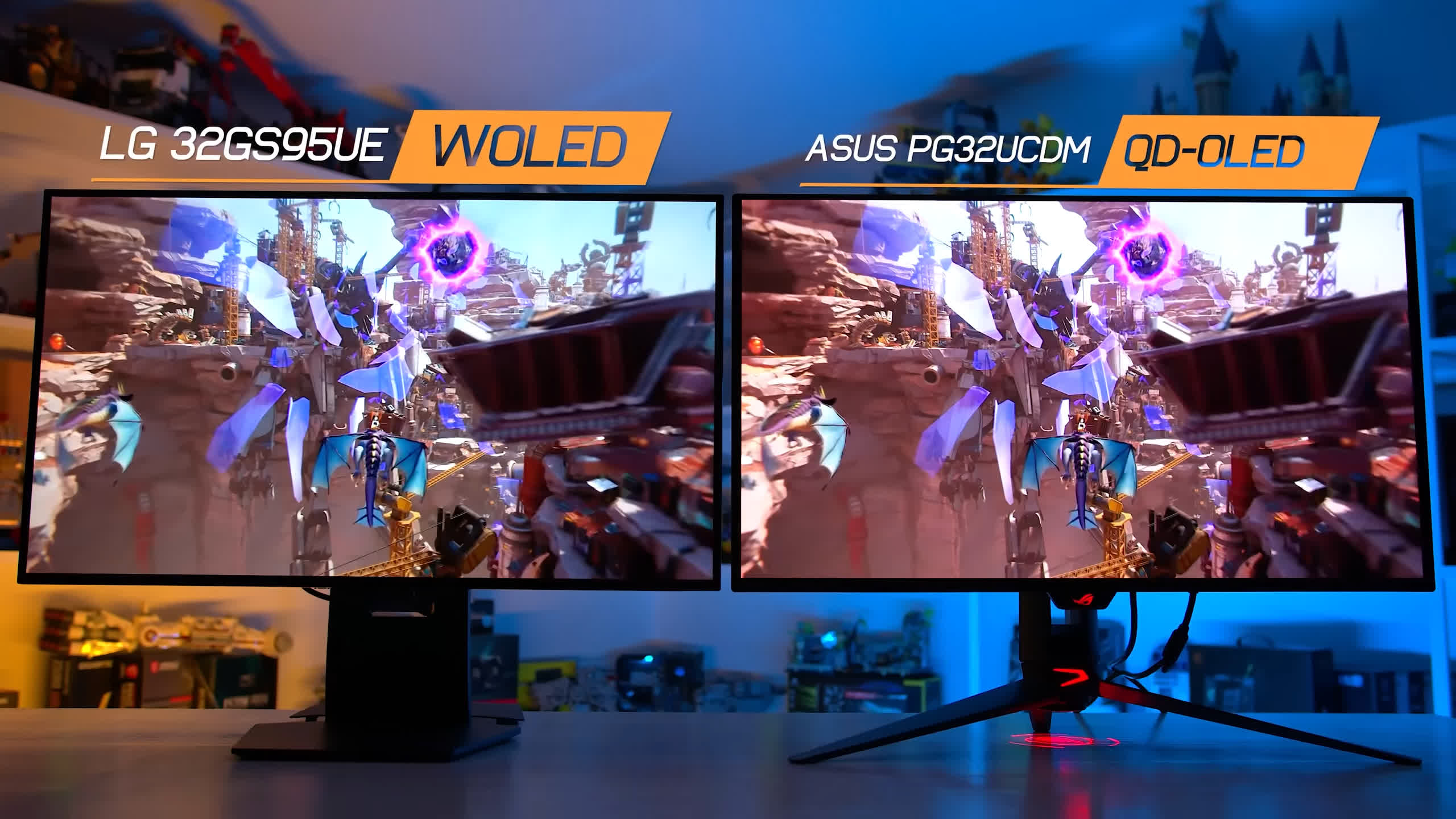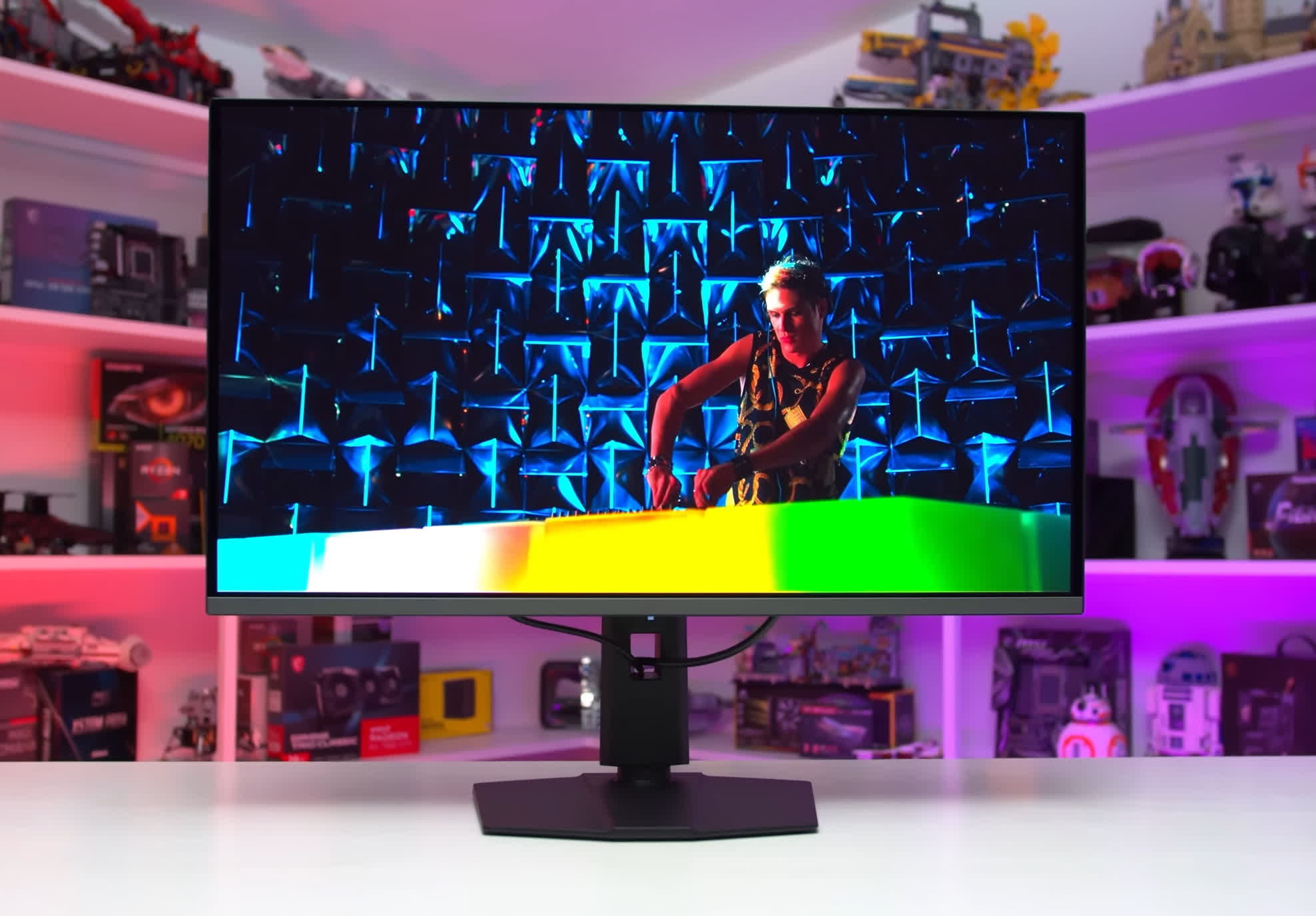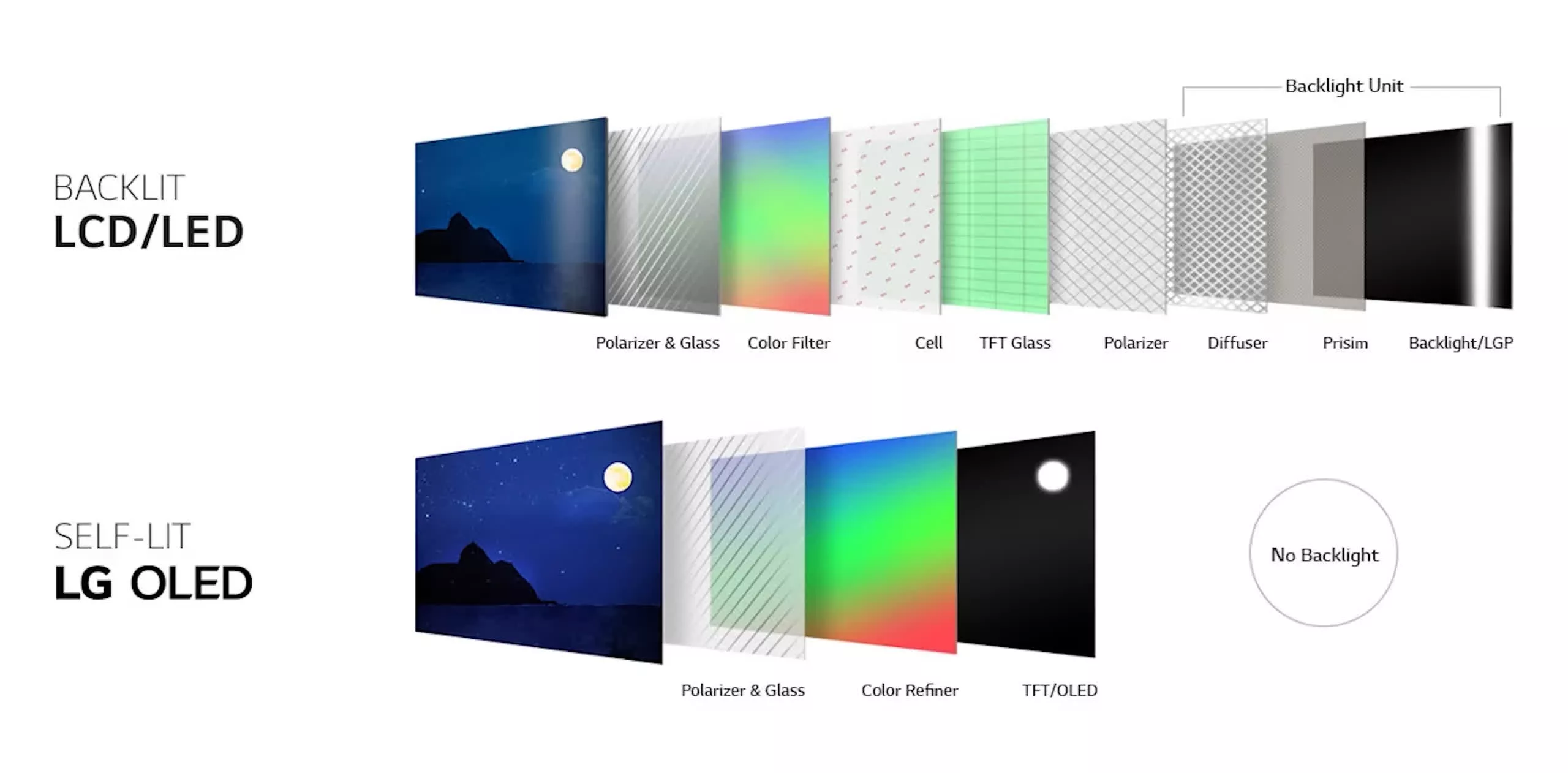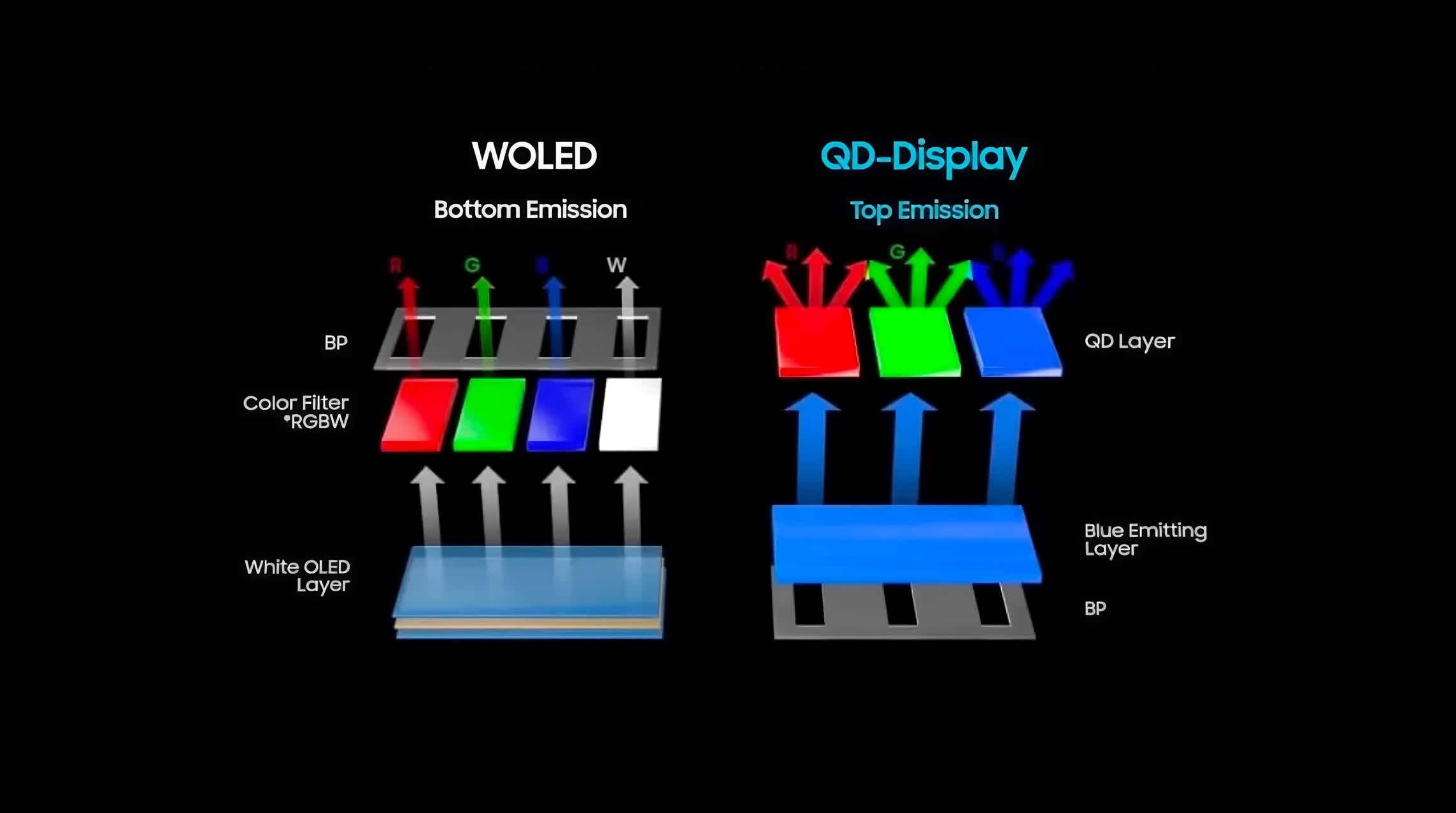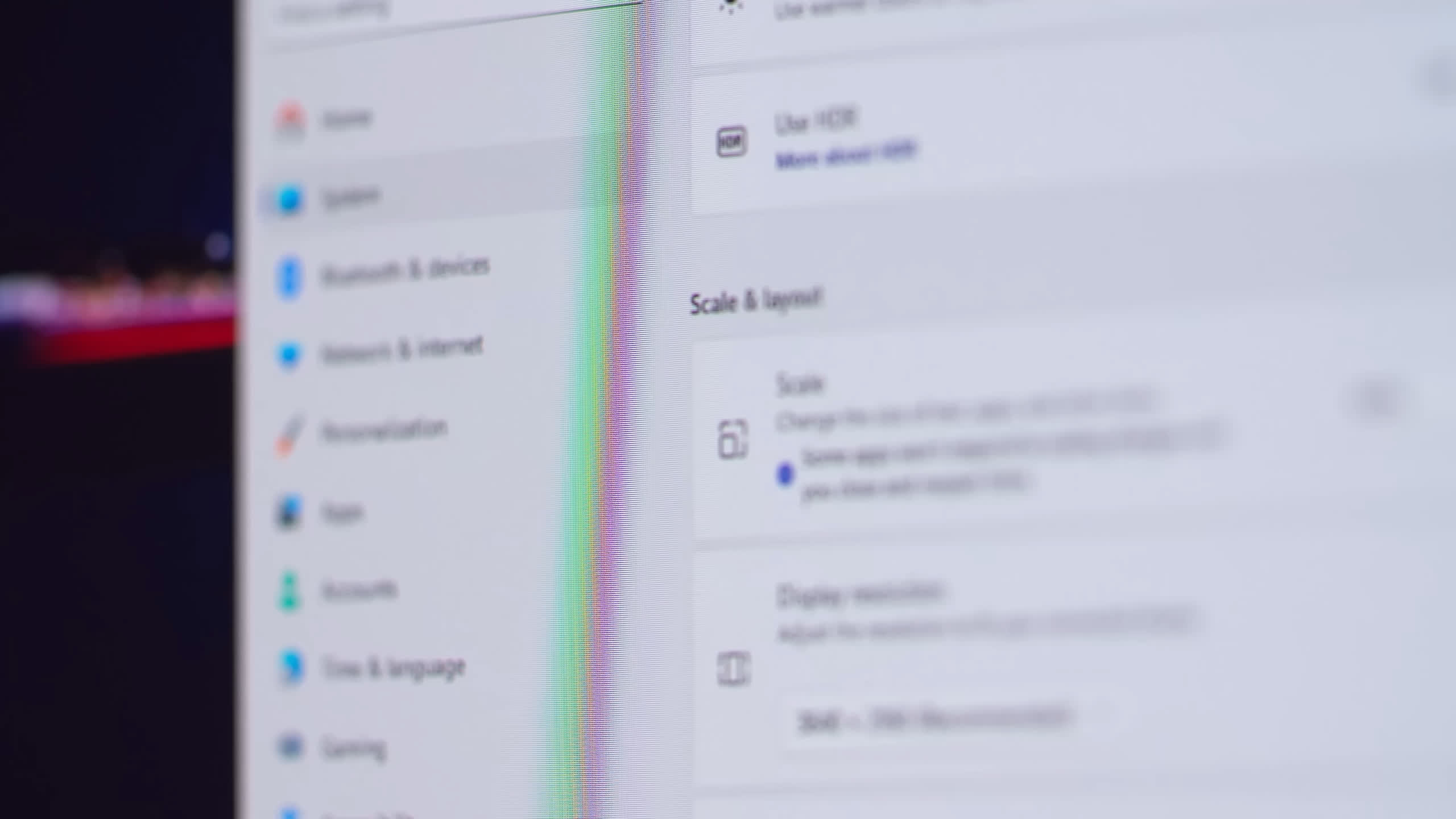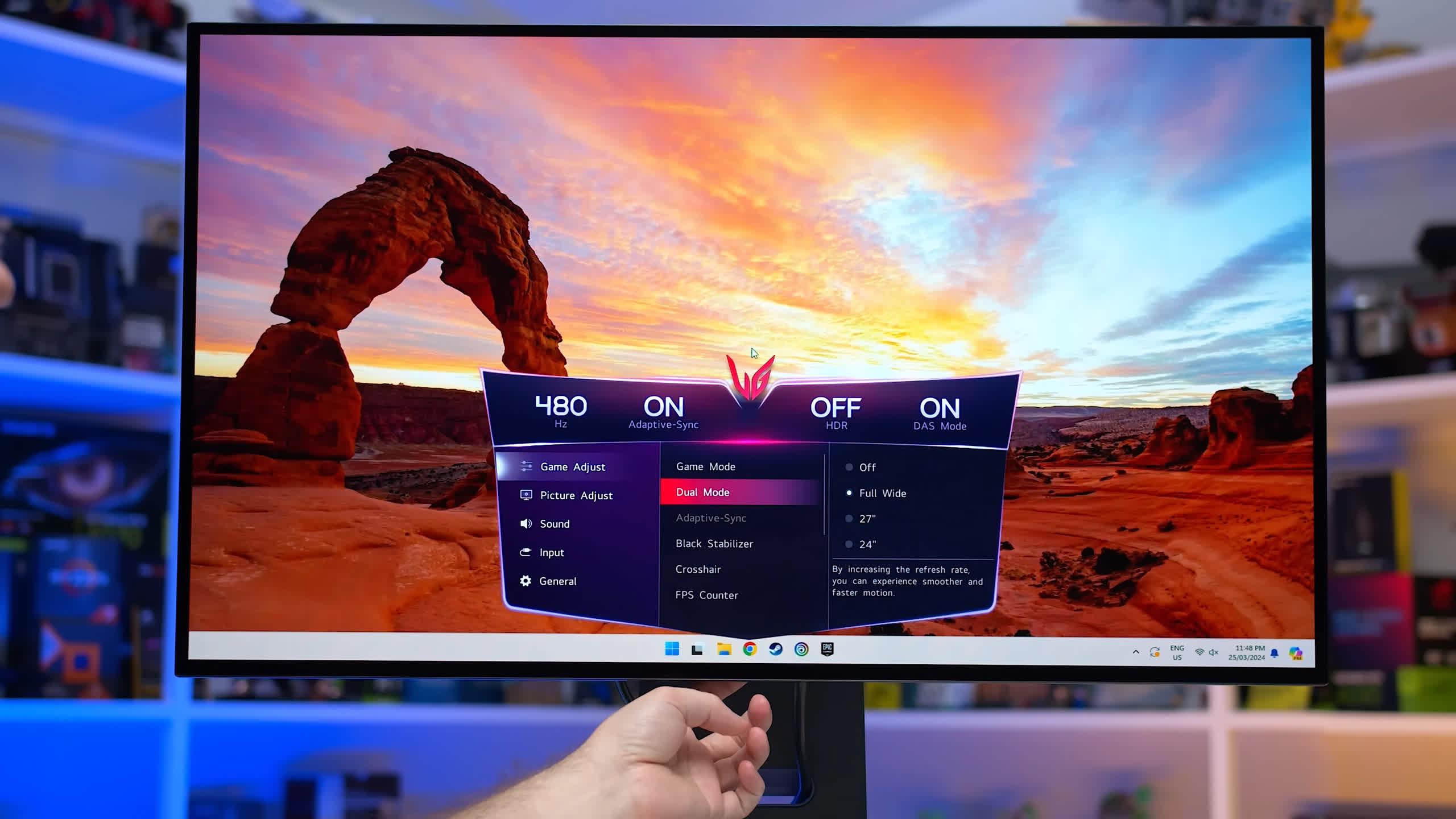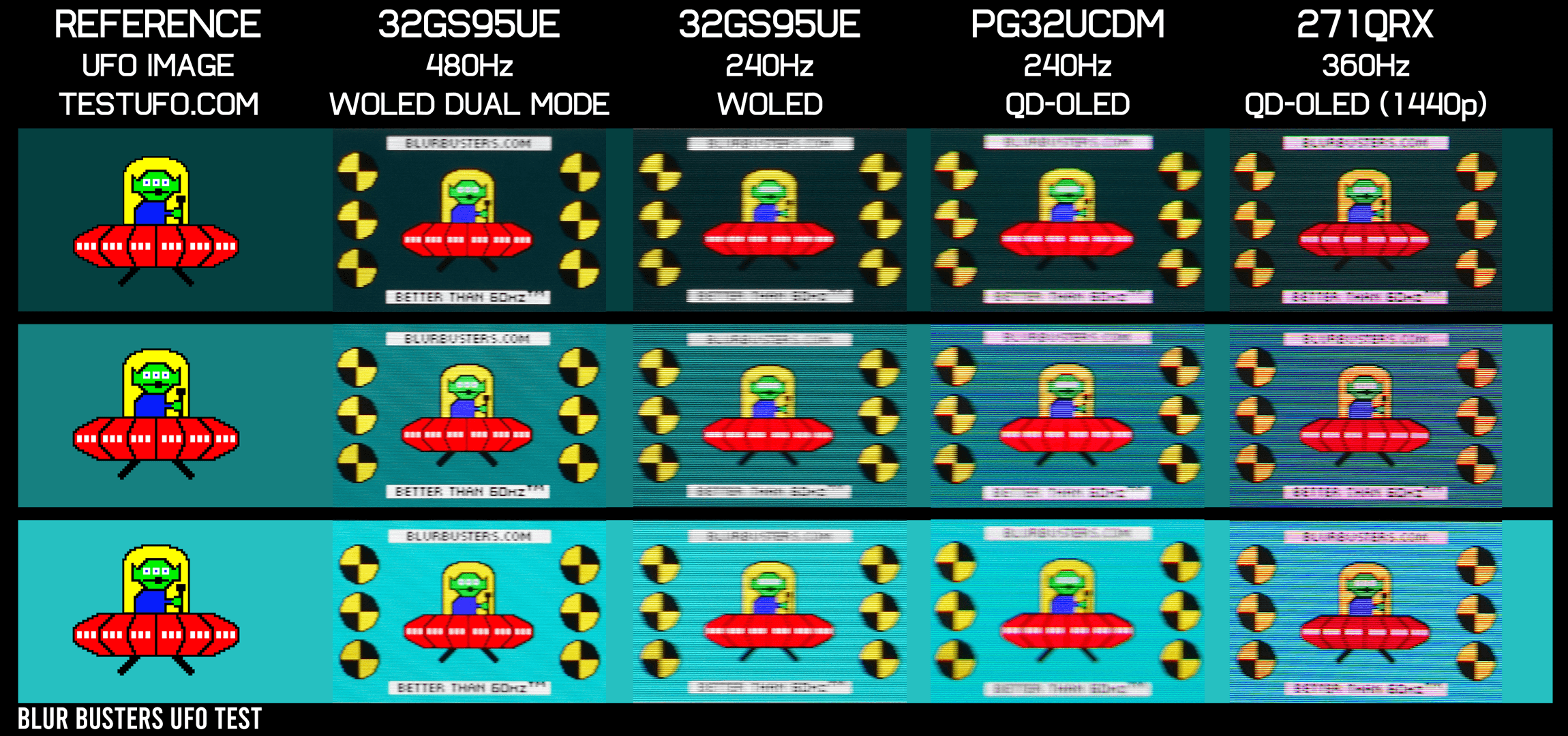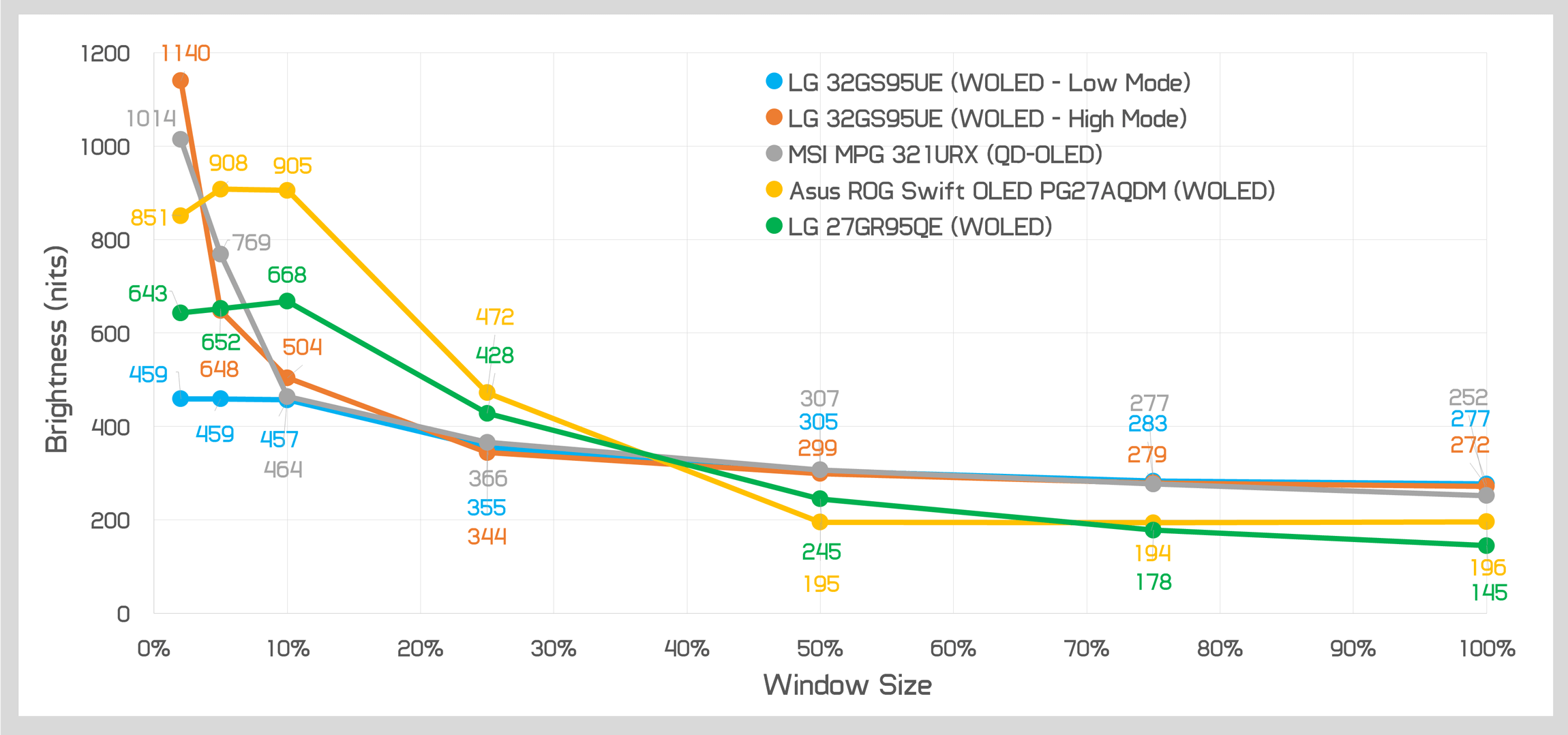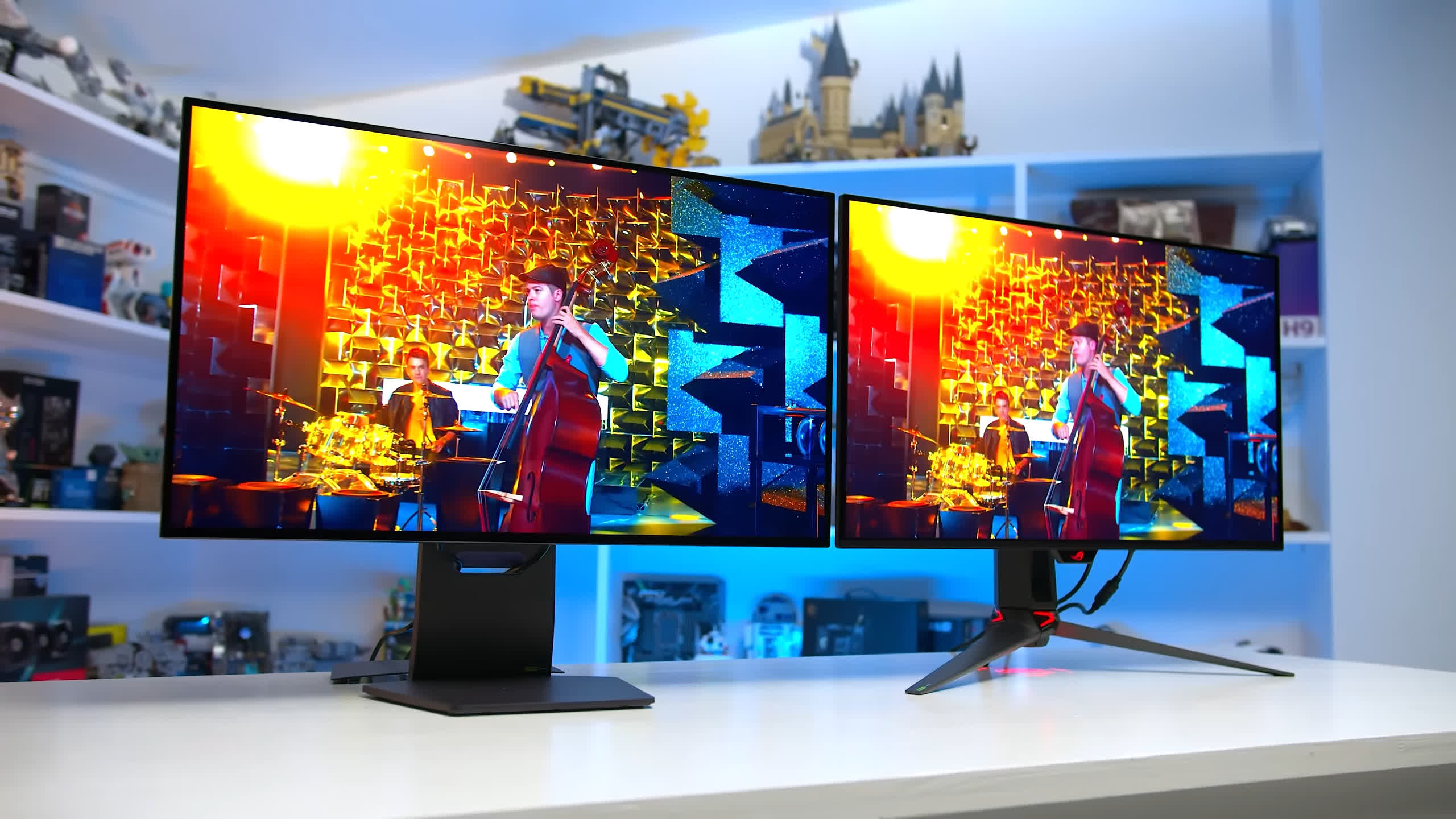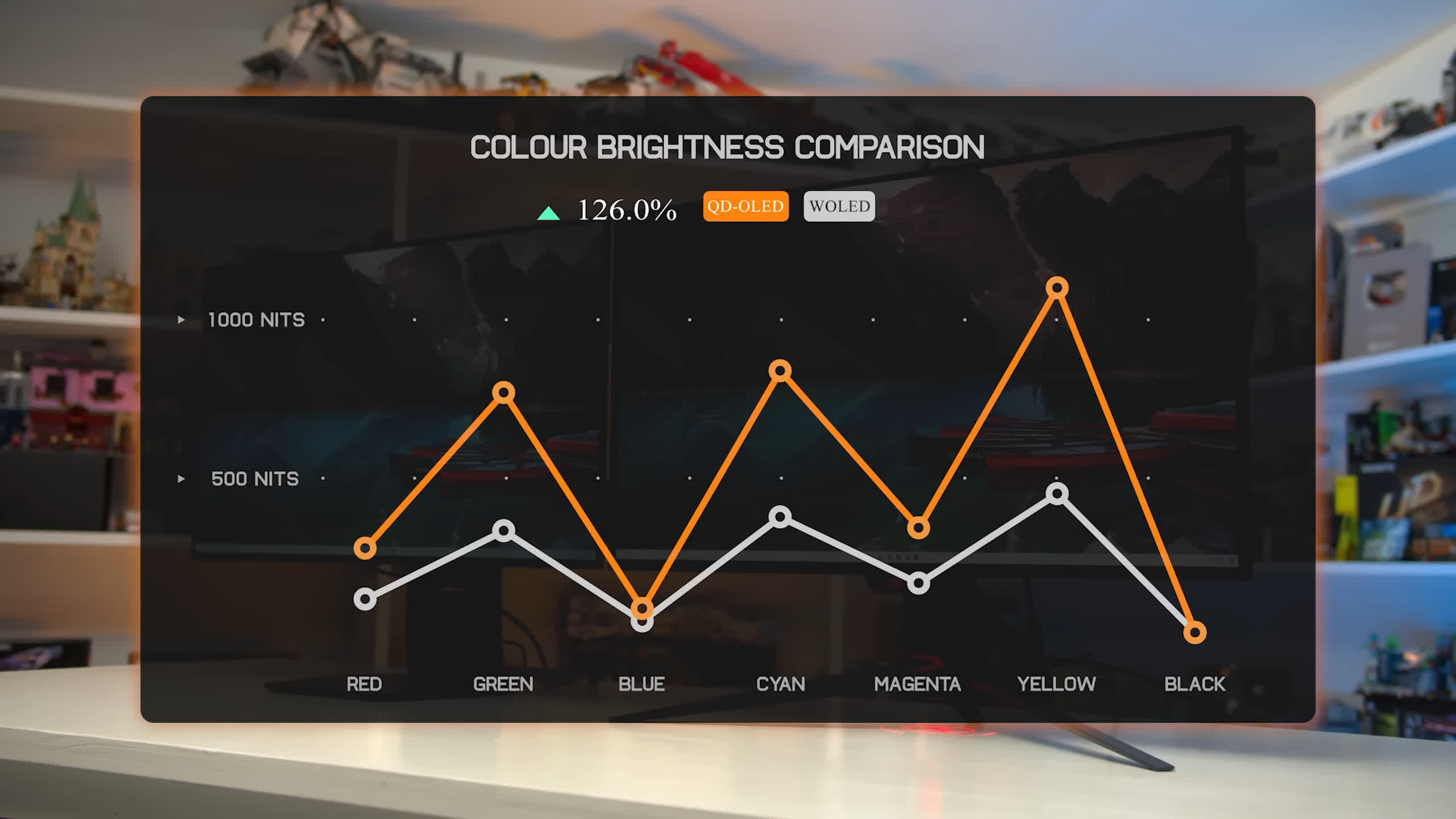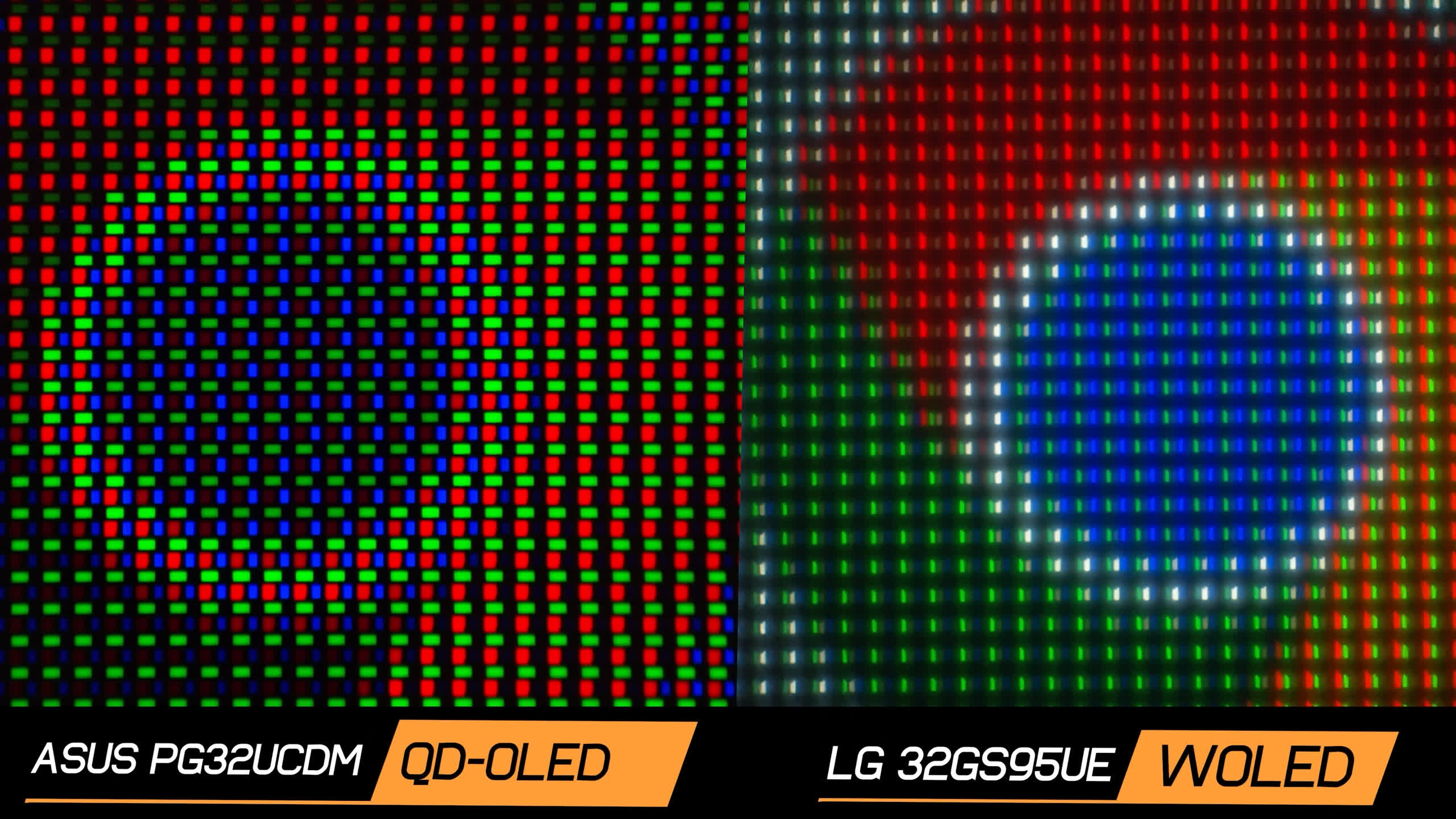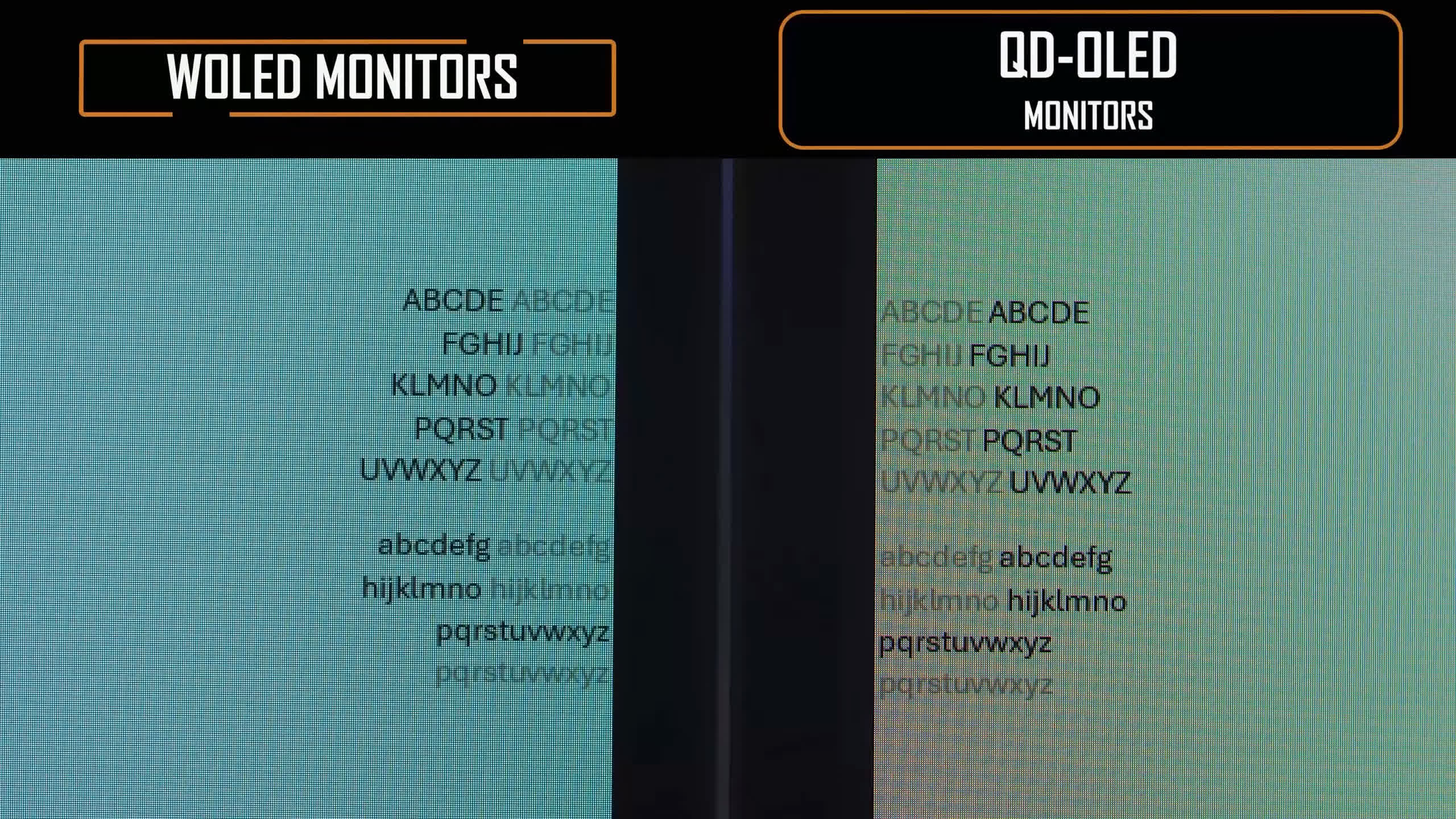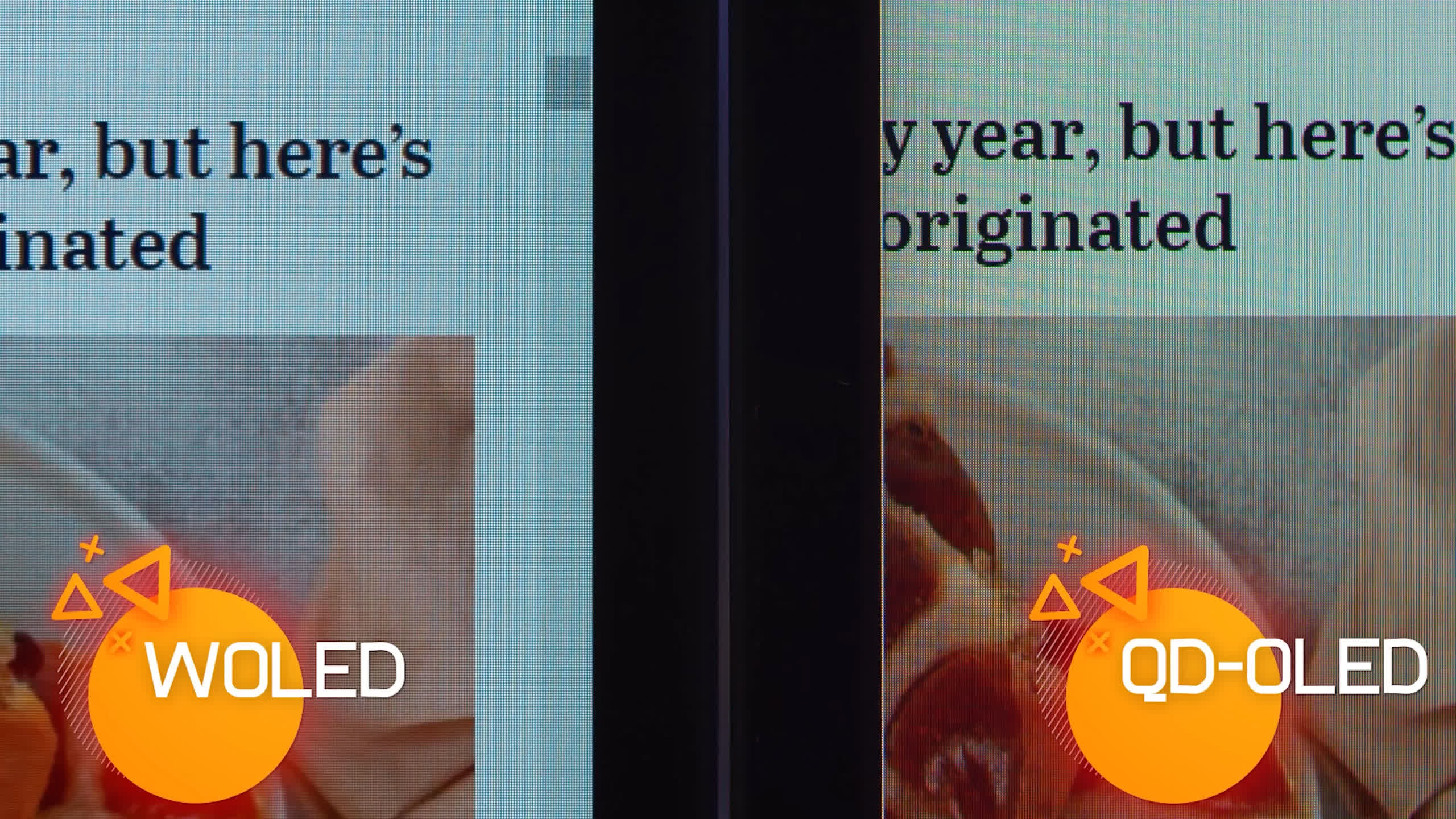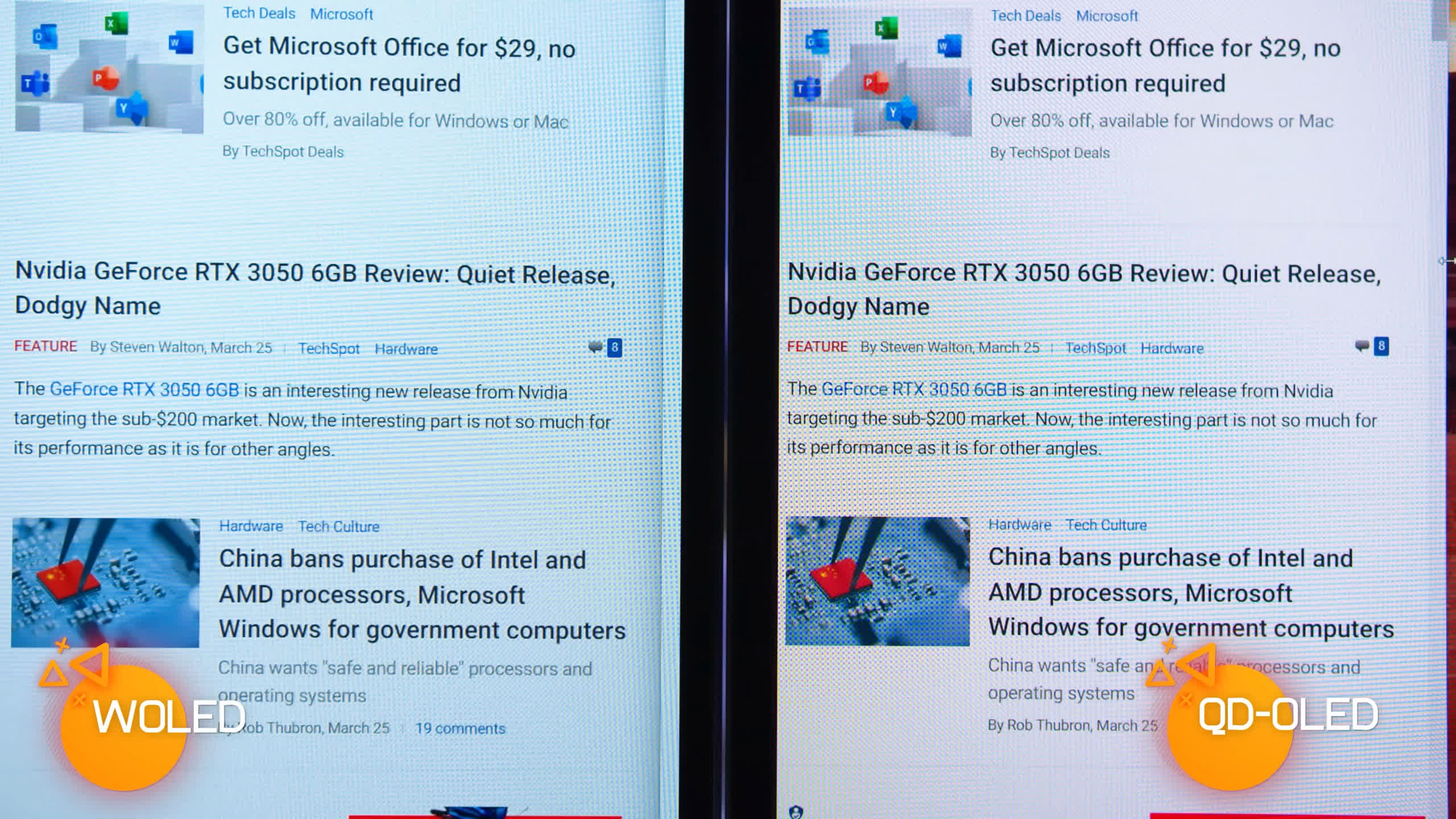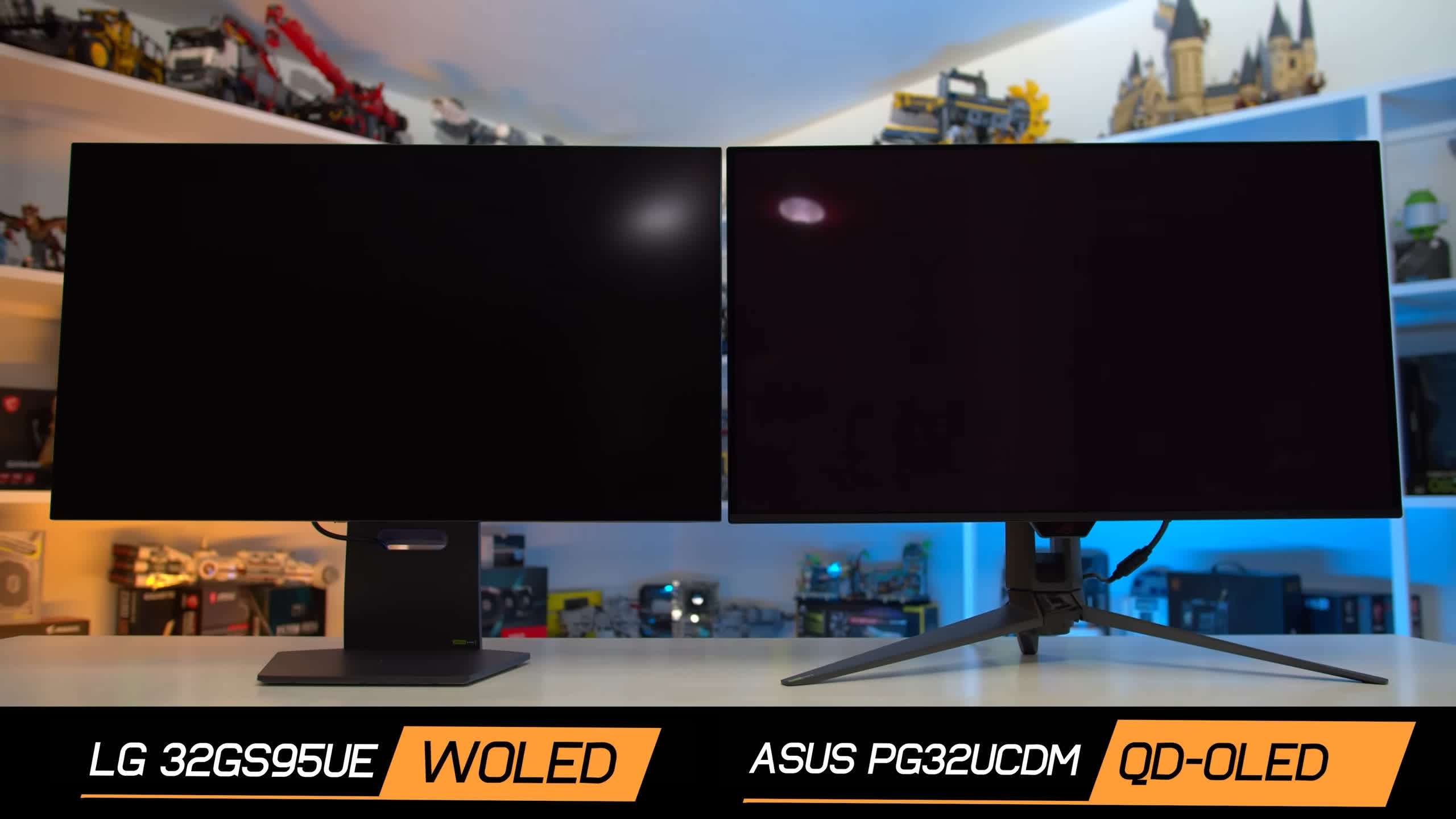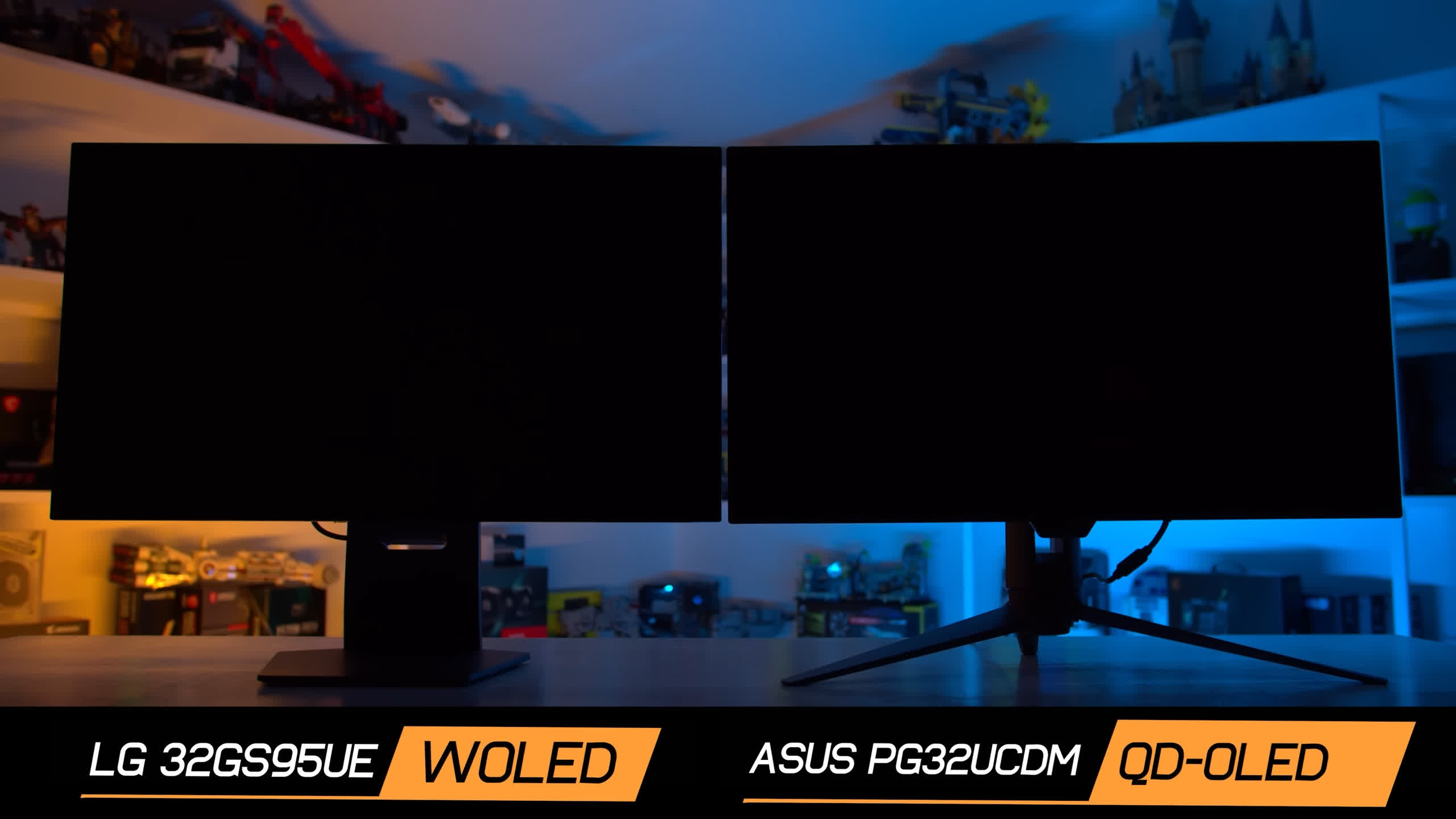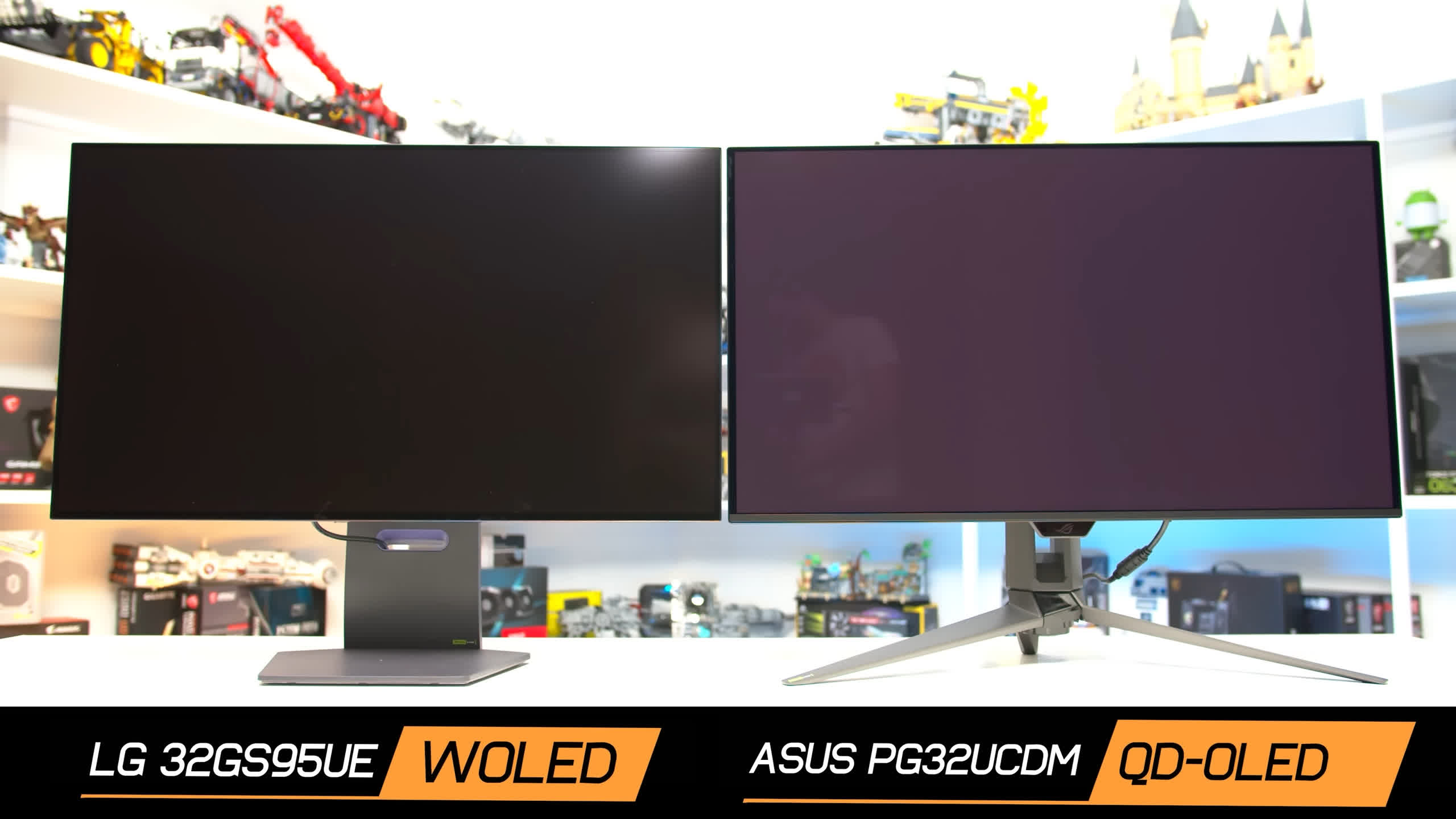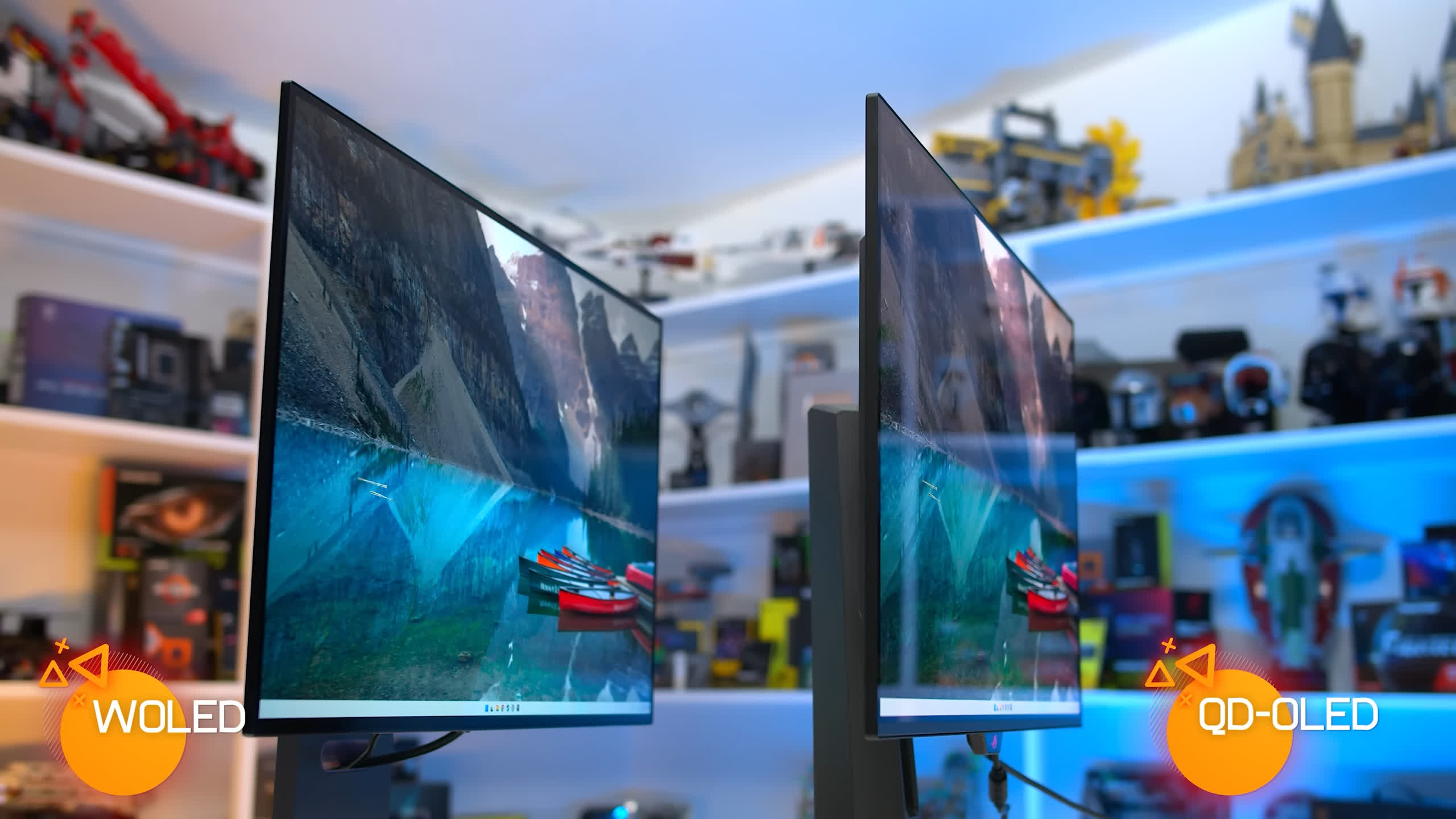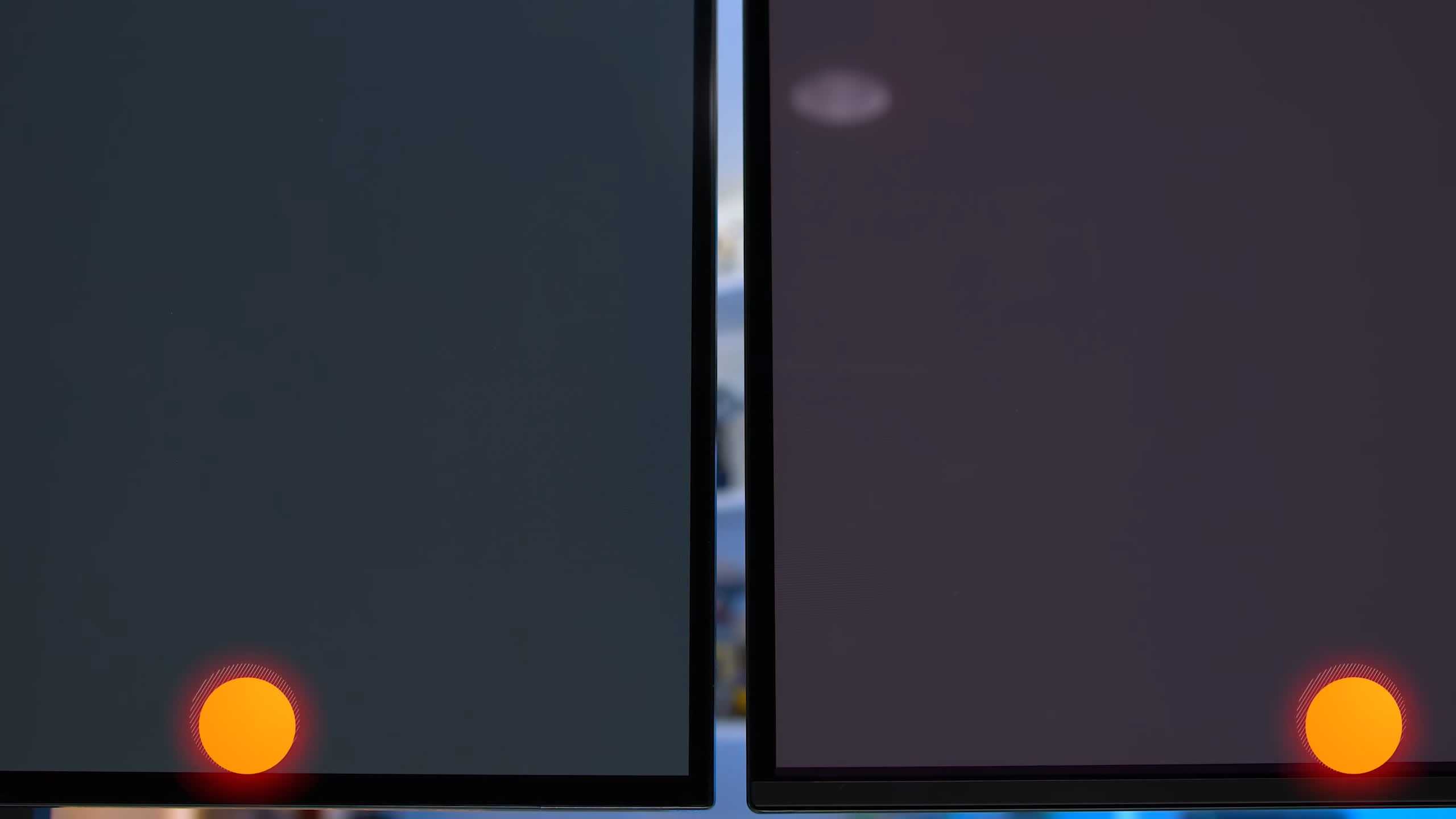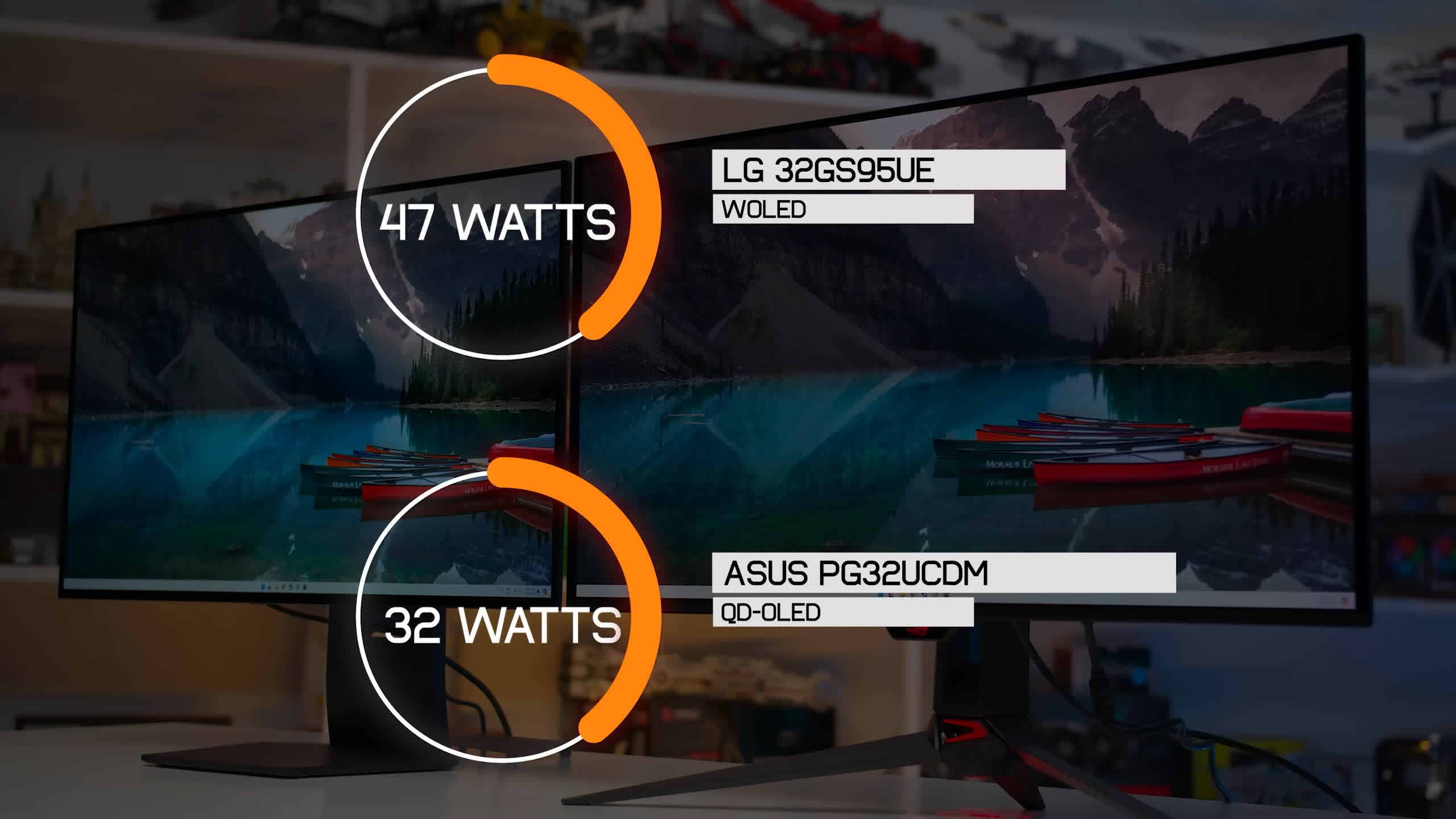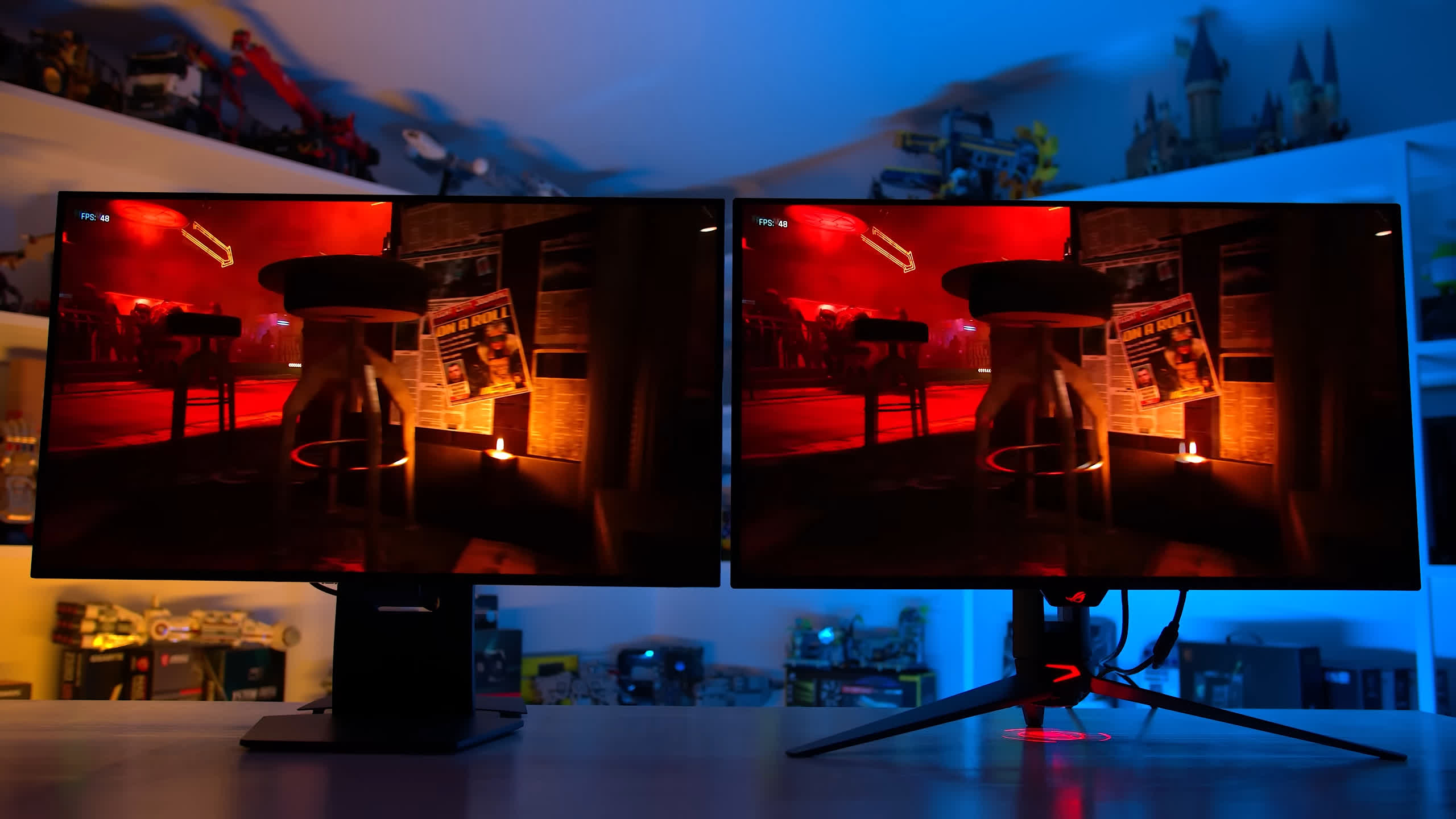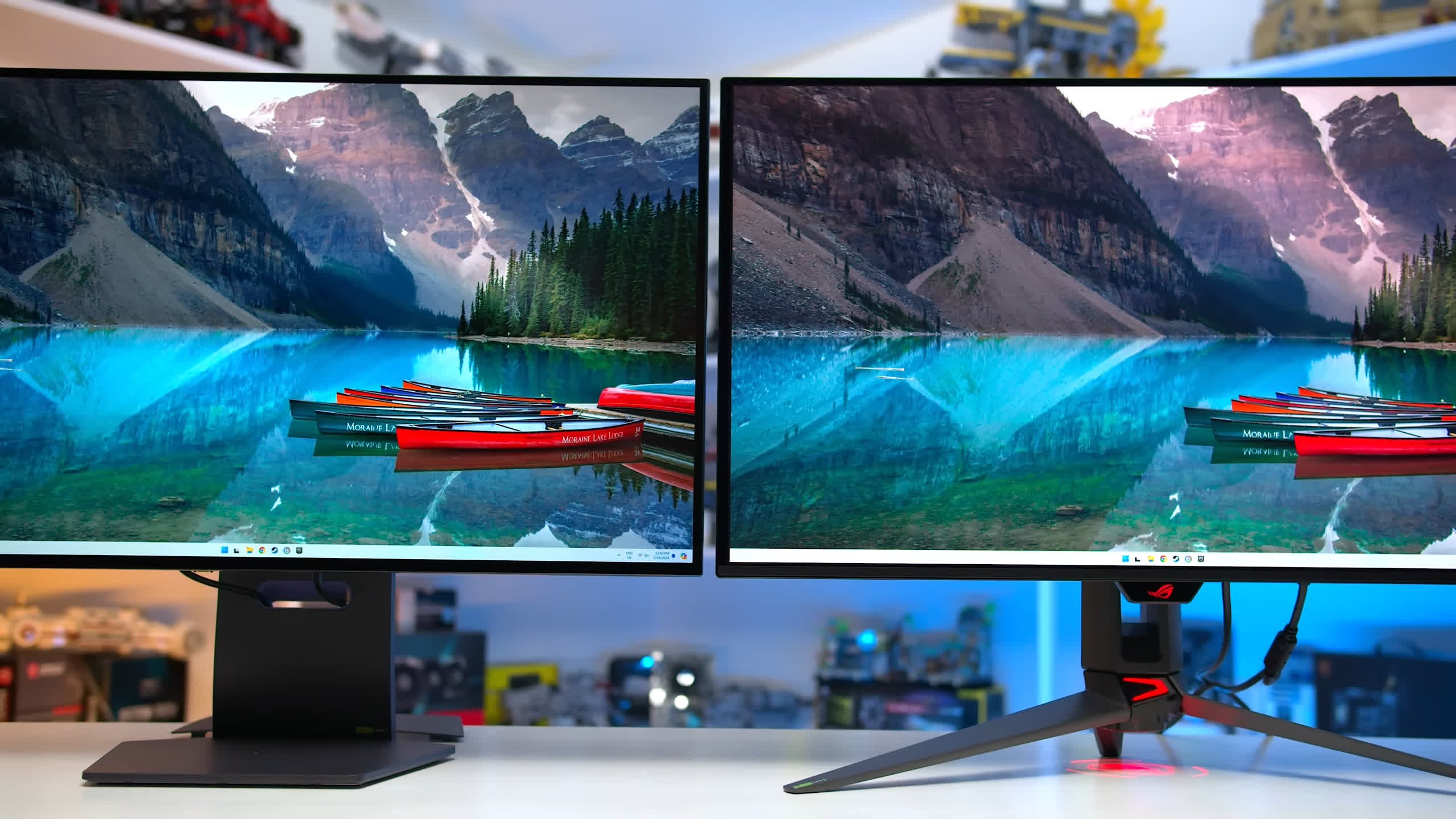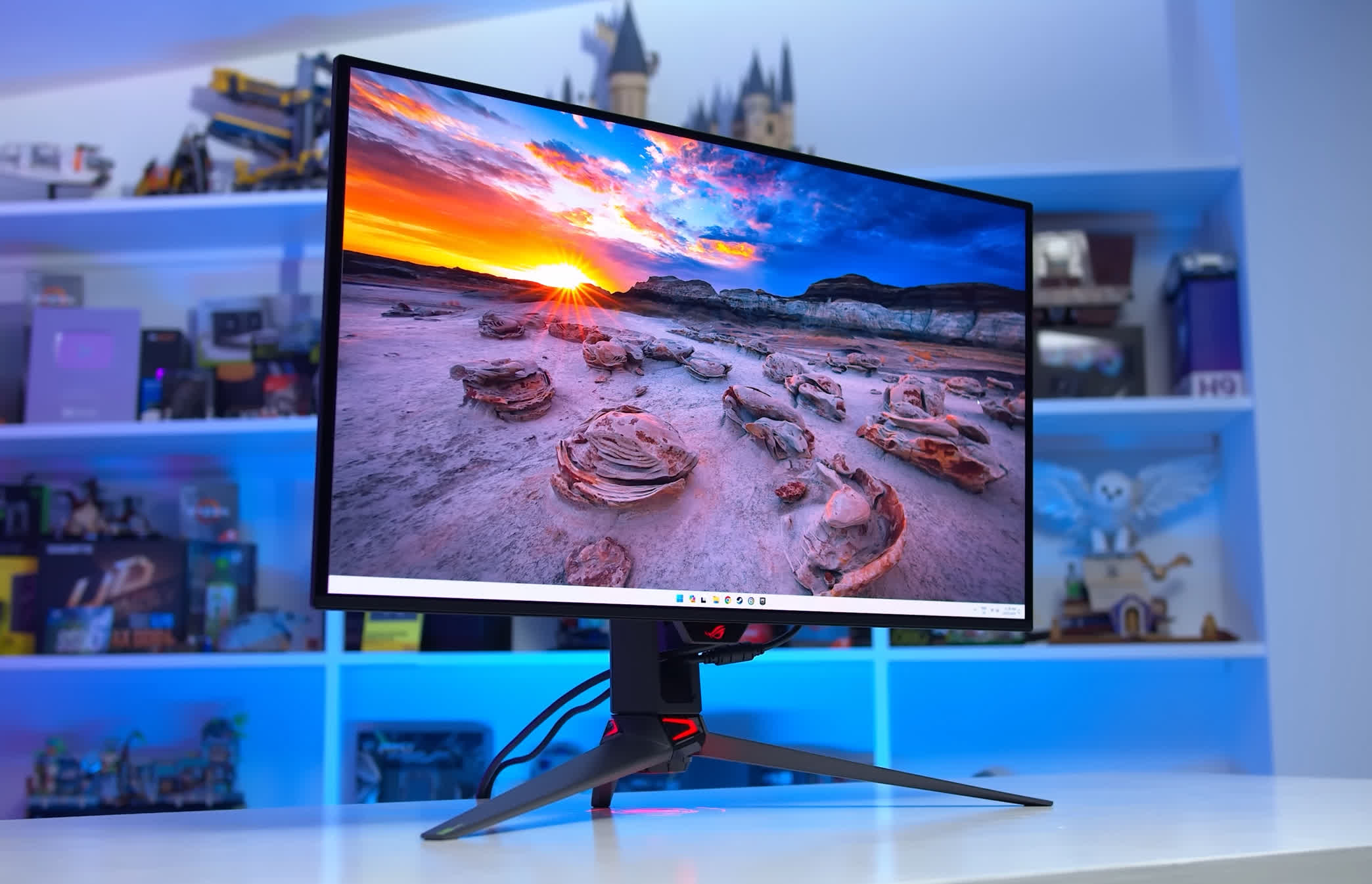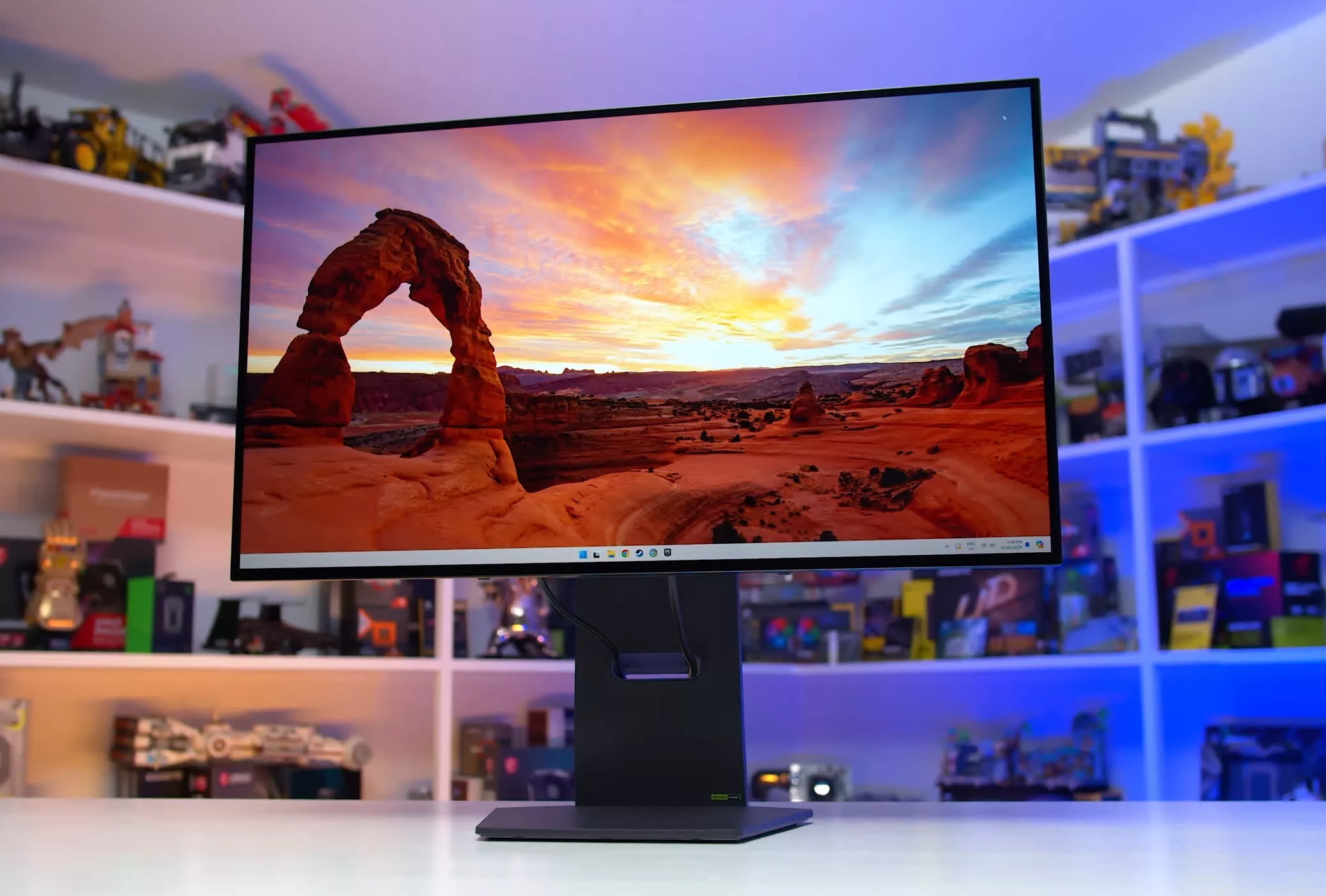Are you thinking of jumping into the OLED gaming ecosystem with a brand new 32-inch 4K fast refresh monitor but aren't sure whether to choose a QD-OLED or WOLED panel? Today's article will provide a thorough comparison of the two, showing precisely which panel performs better in various scenarios, including some side-by-side visuals that we haven't showcased in reviews before.
This year, two new competing OLED panels have been introduced to the market by Samsung and LG, offering base specifications of a 32-inch 16:9 panel format, a maximum resolution of 3840 x 2160 (4K), and a 240Hz refresh rate.
Samsung's QD-OLED panel is already being featured in monitors such as the Asus PG32UCDM, MSI 321URX, and Dell AW3225QF, while the LG WOLED panel has been utilized in the LG 32GS95UE so far. Many more monitors using both panels are set to be released throughout 2024.
What are QD-OLED and WOLED?
QD-OLED and WOLED are both subtypes of OLED displays, which stand for organic light-emitting diode displays. This refers to how the display panel produces light: OLED panels directly emit light from a layer of organic diodes; millions of diodes per panel.
All OLED panels function in this way and offer several key advantages. Since OLEDs directly emit light from each pixel, every pixel can individually control its light output, offering "per-pixel local dimming" – a crucial feature for exceptional HDR presentations. OLEDs can also fully switch off individual pixels to display true black, leading to deep zero-level blacks and rich shadows.
If you've never used an OLED monitor before, the most obvious comparison to make is to an LCD. Liquid crystal displays feature a backlight that emits light which then passes through a layer of crystals that twist to control color and brightness output. Since LCD backlights are either uniform or split into zones, LCDs lack per-pixel control, so you miss out on per-pixel local dimming or the capability to switch off individual pixels.
The crystal transition process in an LCD is also typically slower than an OLED modifying the light output of a given pixel. In summary, the features most sought after in an OLED are its per-pixel control and its transition speed; features that are present in both WOLED and QD-OLED.
Where the OLED subvariants differ is in their panel composition and subpixel structure. WOLED utilizes an OLED layer that emits white light, which then passes through color filters to display red, green, and blue. Additionally, there's a fourth subpixel with no filter, allowing the white light of the OLED layer to pass through. This design, with its fourth white subpixel, gives WOLED its name, standing for "White OLED."
QD-OLED operates differently. The OLED layer in a QD-OLED emits blue light, which passes through a quantum dot layer, modifying the light wavelength to red and green for the red and green subpixels. The blue subpixel passes through the blue OLED light. QD-OLEDs therefore only have three subpixels, and these are arranged in a triangle configuration with green on top and red and blue on the bottom. The QD in QD-OLED refers to the quantum dot layer that's key to its design.
While the underlying technology is still OLED, the way WOLED and QD-OLED panels operate is significantly different, which leads to many differences in performance and other display characteristics.
QD-OLED vs WOLED: Motion Performance
In terms of speed and motion performance, there is little difference between WOLED and QD-OLED response times. Across all the OLEDs we've tested so far, transition speeds are roughly the same: they're lightning fast for both WOLED and QD-OLED, in the 0.3ms range. So, when both panel technologies operate at the same refresh rate – in this case, 240Hz, the maximum achievable for both at 4K – the resulting motion performance is essentially identical.
Unlike with LCD subvariants such as TN, VA, and IPS, you don't have to worry about speed when deciding between WOLED and QD-OLED.
However, with this generation of panels, there is one key difference: LG Display has created a technology they are calling "Dual Mode," which allows their WOLED panel to operate at a lower 1920x1080 resolution with a higher 480Hz refresh rate. Switching between modes, at least on the LG 32GS95UE, is fast and easy through a button included on the bottom edge of the display.
This gives 4K WOLED monitors a clear advantage in motion clarity for competitive gaming because the refresh rate can be double that of QD-OLED. When examining Blur Busters UFO Test results, the difference in clarity between a 240Hz and 480Hz OLED is evident: the 480Hz image is simply much clearer, and elements such as fast-moving text are easier to parse in motion. With a clearer, less blurry image in motion at 480Hz, competitive gamers have an advantage in spotting enemies in fast-paced battle scenarios.
Of course, to achieve 480Hz on a WOLED, you have to sacrifice resolution, and a 1080p image on this monitor doesn't look as sharp in terms of text clarity or sharpness, especially compared to the native 4K mode. But, it's purely an optional mode that has no impact on the 4K 240Hz mode, so in the best cases, a 4K WOLED panel can be faster in competitive scenarios if you're willing to drop the resolution, and in the worst cases, a 4K WOLED will be equal to a 4K QD-OLED in clarity when both are set to 4K 240Hz.
The higher refresh rate in the Dual Mode configuration also gives WOLED an edge in input latency. While all 4K OLEDs that we've tested have had excellent sub-1ms processing delays in their SDR and HDR modes, the higher 480Hz mode has less refresh lag and lower overall latency because the refresh rate is twice that of the 240Hz mode. So, when comparing WOLED and QD-OLED input lag, they're both roughly the same at 4K 240Hz, but WOLED panels are capable of even lower lag when set to the 480Hz mode.
If you are primarily a single-player oriented gamer who will mostly use the 4K mode, there's little difference between the OLED technologies for motion. If you're a competitive gamer, the 480Hz mode provided with WOLED is clearer and provides lower latency, giving it a notable advantage.
QD-OLED vs WOLED: Brightness
Brightness is always a significant talking point when it comes to OLED, as this is a known weakness compared to LCDs. There are some differences between 4K WOLED and 4K QD-OLED panel brightness, but they might not be as significant as you might think.
Panel brightness isn't always consistent across implementations, especially with WOLED. Last year, with 1440p monitors, some manufacturers like Asus were able to offer higher brightness than others using the same panel. QD-OLEDs tend to be more consistent in brightness capabilities across models, though brightness accuracy can vary. The following discussion is based on testing just a handful of the 4K OLED models that will be available this year.
SDR brightness is basically the same between the WOLED and QD-OLED models we've tested so far. Both panel variants offer 250 nits in the SDR configuration, with uniform brightness modes available or enabled by default. Neither is particularly bright, but there's no advantage either way.
In HDR brightness, both panel types appear capable of a similar level of peak performance. Based on testing the 32GS95UE, 2% and 10% window size brightness can get slightly higher on the WOLED model, while 5% is higher on the QD-OLED models. This is based on synthetic testing using standard patterns.
For brightness accuracy, this will vary depending on the model you get. So far, the QD-OLED models we've been testing have achieved greater EOTF tracking accuracy than the WOLED model from LG, but across the last few years of testing OLEDs, this is more related to how the specific product is tuned than the panel technology used.
It pays to look at reviews to see which specific models are the best in terms of accuracy; it's possible that other WOLED monitors coming in the next few months will offer similar accuracy for HDR EOTF.
Brightness accuracy might also affect real-world results. While test patterns show brightness trading blows between WOLED and QD-OLED, in real scenes, the QD-OLED monitors we've tested have typically been brighter. For example, in our low APL video test, the MSI 321URX hits 897 nits, whereas the LG 32GS95UE in its brightest mode achieves just 603 nits. There's a less substantial difference in mid APL scenes, but still an advantage to QD-OLED. However, this should be assessed per model as even some QD-OLEDs don't perform the same, as seen with the differing results between the MSI, Asus, and Dell models.
What won't change between models is that QD-OLED has significantly higher color brightness than WOLED. The brightness results discussed so far relate to white brightness, which on WOLEDs is enhanced thanks to its white subpixel. When displaying bright, highly saturated colors, the white subpixel has no effect, leading to poorer results on a WOLED panel.
Typically, color brightness on a QD-OLED is more than twice as high as on a WOLED. For the primary colors, red brightness improves from 105 to 241 nits going from WOLED to QD-OLED, green improves from 296 to 686 nits, and blue improves from 34 to 69 nits. You'll also see large gains for the mixed colors like cyan and magenta. This means that when content requests a bright and highly saturated element, like a neon sign, the QD-OLED screen will get much brighter.
QD-OLED vs WOLED: Color Volume and Space
This leads to a significant advantage for QD-OLED in color volume. Based on low APL testing, where both panels are producing their brightest outputs, QD-OLED achieves around 73% Rec. 2020 color volume, compared to just 34% for WOLED. The advantage clearly goes to QD-OLED for displaying the largest portion of the HDR color and brightness range.
There's a less significant difference in color space coverage, though. WOLED typically sits around 72 to 73 percent Rec. 2020 color space coverage, whereas QD-OLED is in the 80 percent range. So, while QD-OLEDs can display a broader range of colors than WOLED, when brightness isn't factored in, both panel types do offer a wide color gamut suitable for HDR.
QD-OLED vs WOLED: Text Clarity
Text clarity is a major talking point with 4K QD-OLED and 4K WOLED panels. Both of these new, higher density panels offer better text clarity than previous iterations, and in our opinion, for typical usage, the text quality of either is decent enough.
You won't see text quality that's quite as sharp as an LCD of the same size and resolution, but for most applications like web browsing or writing documents, it's pretty good – and we've been using a 4K QD-OLED for productivity for over six weeks now with no real issues.
With the 32-inch 4K panels, QD-OLED and WOLED render text differently due to their distinct subpixel structures. WOLED uses an RGWB configuration in stripes, whereas QD-OLED uses a triangular RGB configuration, with the green subpixel positioned above the red and blue.
Modern operating systems employ subpixel text rendering techniques to enhance text quality, and these techniques are designed around the traditional RGB stripe subpixel layouts seen in LCD panels. Any deviation from the RGB stripe leads to diminished text quality – and both QD-OLED and WOLED feature different layouts than the RGB stripe.
In our experience, at 140 PPI, the artifacts with 4K OLED text rendering are difficult to spot, but there are distinct artifacts with QD-OLED and WOLED. QD-OLED typically exhibits a bit of pink-green fringing at the bottom and top of text, respectively. WOLED commonly shows some shadowing along the fine left or right edges of text.
Based on our typical use of these panels with 125% scaling in Windows, we find the shadowing on WOLED more noticeable than the fringing on QD-OLED. However, after examining a range of different configurations, this can vary depending on everything from text size and font to text color and background.
Some of these things can be hard to visually show on camera as getting closer to the screen with greater magnification often leads to footage that shows individual pixels, which is not really representative of how this sort of pixel density is viewed at a normal distance. However, we'll try our best to explain.
Essentially, the smaller the font size, the better QD-OLED tends to look. When viewing small font sizes, the edge definition around certain lowercase letters (like "b," "f," and "p") is sharper on QD-OLED. Not all letters look better, but generally, we think QD-OLED has the edge. With that said, the smaller the font, the more likely fringing will appear, though it's much more visible in footage than in real life.
With larger font sizes, it becomes more of an even match. For instance, QD-OLED handles letters like capital "E" and lowercase "n" better, but WOLED is superior for capital "T" and lowercase "j." The differences are also less pronounced for white text on a black background, as well as for various colors of text, like red or green.
Having used both panels side by side, we prefer the way QD-OLED renders text in Windows. However, we don't think it's a significant issue, and buyers should largely be satisfied with the text quality offered by these OLEDs – it's significantly better than previous OLED panels.
If having the best text quality is a must, then IPS LCD will be the best choice. But in 2024, the density and subpixel structure of these OLEDs are "good enough" for typical use.
QD-OLED vs WOLED: Screen Coating
The screen coating used for QD-OLED and WOLED is substantially different. QD-OLED uses a glossy coating for the monitors released so far, whereas WOLED uses a matte coating. LG Display's choice to go with matte for their panels has sparked some debate. However, in our experience, whether glossy or matte is better can be highly subjective and may depend on how you use your monitor.
WOLEDs use a screen coating and panel composition that is more effective in brighter ambient environments. The use of various filters results in less reflection of ambient light, preserving the deep blacks of OLED in more conditions. In brighter environments, especially with lighting in front of the display, matte WOLED will appear to have deeper blacks than a glossy QD-OLED. In a side-by-side comparison, the "blacker" appearance of WOLED when displaying black, compared to the red-grey of QD-OLED, which reflects more ambient light, is evident.
The matte finish also helps WOLED reduce defined mirror reflections compared to QD-OLED. In bright environments, some objects reflected in a glossy QD-OLED display can be clearly seen, and this is especially problematic if there are bright objects like lights or windows opposite your monitor. On a WOLED, these elements will be diffused and less distracting, although any light is generally still reflected to some degree. The glossy finish on QD-OLED is also among the better coatings for minimizing mirror reflections, even if they are still present.
On the other hand, there are some setups where QD-OLED will be preferable. Optimizing light placement to avoid direct reflections on the display will greatly reduce ambient light reflectivity, and it is possible, in some cases, to have QD-OLED reflecting less light in general, making use of the glossy finish's ability to prevent light diffusion. This will be a case-by-case basis, though, and could require some effort to optimize.
But generally, if you can position light sources largely behind the screen, QD-OLED will end up looking better than the matte WOLED coating, as there is no coating grain. This gives QD-OLED the appearance of greater clarity and a more crisp presentation. With no noticeable light diffusion, it also enhances the apparent contrast in some situations, providing more 'pop' to vibrant, high contrast scenes. The WOLED coating grain is moderate in nature and can be noticeable in some situations, though we personally don't find it bothersome.
In a dark environment, such as gaming with the lights off, there's really not much of a difference between QD-OLED and WOLED, except for coating grain. Both panel types will produce the same rich, zero-level blacks with no ambient light in the room; the matte finish does not impact blacks in this type of environment, nor does the QD-OLED panel's poor handling of ambient light reflections.
To summarize the difference in coating, generally, you'd prefer a matte coating if you're mostly going to use the monitor in a brighter environment and a glossy coating when using it mostly in a darker or light-optimized environment.
QD-OLED vs WOLED: Viewing Angles and Uniformity
Both QD-OLED and WOLED variants offer similar viewing angles, excellent in both cases with little falloff in colors or brightness when viewing at off angles. Both panel types have excellent edge-to-edge uniformity due to their high viewing angles, so at a typical viewing position, there are no obvious issues when viewing the corners of the screen.
One thing to note, though, is if you are interested in a curved 4K OLED monitor, currently, that is only offered with QD-OLED technology. The Dell Alienware AW3225QF uses one of Samsung Display's curved panels, whereas LG Display is only producing flat WOLEDs in this format at the moment.
While generally, uniformity is quite good with both WOLED and QD-OLED, for dark grey shades, WOLED can suffer from artifact issues we label the "dirty screen effect."
This is difficult to capture on camera, but essentially, when viewing large uniform sections of dark grey, like those found in some applications, QD-OLED will display these sections "clean" with great uniformity, whereas WOLED has a bit of dirty "speckling" that makes these sections less uniform. It's a minor annoyance that may affect some applications, but as large grey sections like this are uncommon in video content or gaming, it won't affect many of the typical OLED use cases.
Power consumption also differs between QD-OLED and WOLED, though it depends on the content you're viewing. When content is predominantly white, WOLED is typically more efficient thanks to the use of a white subpixel, using around 35 to 40 percent less power than QD-OLED for pure full-screen white. However, in other scenes where the white subpixel has little to no advantage, like viewing the Steam Store homepage, the situation is reversed, and now QD-OLED is more efficient. In this example, we saw 47 watts on the WOLED and 32 watts on the QD-OLED.
Other aspects of performance will largely come down to individual models and units. Color calibration is one example where this will differ depending on the brand, as will features like KVM switches, color space emulation modes, port selection, and burn-in warranties. However, based on what we've seen announced so far, it seems that if you want Dolby Vision support, that will only be provided through QD-OLED variants.
Choosing Between the Two
When choosing a new 32-inch 4K OLED monitor and deciding whether to go QD-OLED or WOLED, there's more to consider than might first appear. The two panels available right now are based on the same underlying technology, but their implementation, performance, and features are quite different.
The key similarities relate to the fundamental aspects of OLED. Response times and motion performance are the same at the same refresh rate, and both variants offer deep zero-level blacks and per-pixel local dimming, leading to excellent HDR.
We've also observed similar SDR brightness, the same excellent viewing angles, and a similar risk of burn-in – at least for now, we don't have the evidence to say which OLED technology is more resilient.
But there are also going to be areas which will depend on the individual products and models offered by the monitor makers. Calibration in both SDR and HDR modes, brightness accuracy, port selection, additional processing features, burn-in warranties, and so on, are all controlled by the makers and will differ between models, so as always, check reviews.
When it comes to the differences, though, there are clear strengths to each OLED variant. The 4K WOLED panels have the edge in motion clarity with their Dual Mode functionality that allows them to run at 1080p 480Hz, lowering input lag and increasing clarity for competitive gamers. While there's no real difference at 4K 240Hz, the ability to run at that higher refresh rate will be highly attractive to those that love to play fast-paced titles.
QD-OLED has the advantage in color quality. This OLED type has a wider color gamut and much higher color volume, as color brightness is significantly higher compared to WOLED. While WOLED theoretically can produce higher peak white brightness, in practice, so far, we've seen QD-OLEDs get brighter in most HDR situations, although this could vary between units.
We also noticed better uniformity on the QD-OLED panels with no dirty screen effect, and so far, QD-OLEDs are the only type to support Dolby Vision – though it seems more of a scaler limitation than a WOLED panel limitation as to why the WOLEDs announced so far haven't supported Dolby Vision.
There are some areas that will come down to personal preference, too. QD-OLED panels are mostly glossy, while all 32-inch 4K WOLED panels are matte. Each coating has its strengths and weaknesses, and people tend to have strong preferences as to which is better. We think QD-OLED is better in darker environments, and WOLED is better in bright environments.
All in all, we don't think there's an obvious winner, but instead we would recommend each panel to a different type of buyer. If you love competitive multiplayer gaming, we think 4K WOLED with its Dual Mode functionality is the clear choice, but for single-player HDR gaming, the higher brightness and superior color volume of QD-OLED is more attractive.
In terms of choosing an actual monitor to buy, that will depend more on the final product than just the panel used. As of writing, we think the LG 32GS95UE WOLED is too expensive and it's lacking a few features compared to QD-OLED alternatives. But more WOLEDs are coming, which may be more competitive in these areas. The best 4K QD-OLED gaming monitor at the moment is the Asus ROG Swift PG32UCDM, even though the differences among the current models – motion clarity, response times, and brightness – are minor, the overall performance of the Asus monitor stands out.
We're happy to see some healthy competition and plenty of great options though. Having two panel variants means more options for buyers, more competition to drive prices down, and hopefully, enough reasons to incentivize further development and innovation among OLED gaming panels.
